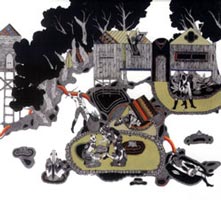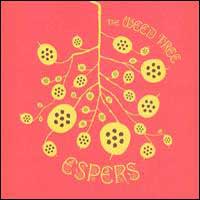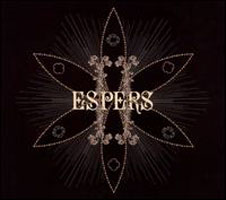It's been a pretty vast musical journey so far: from the freak folk of Espers' debut album to the wide-ranging psychedelia of their covers EP, to 2006's II, an album stepped in British folk formalism and drenched in overtone modal drones and careening electric guitars that added sheer rock power to the flowery proceedings. On III, the Philadelphia quintet do a bit of a mirror flip. While this album sounds brighter, cheerier, and more upbeat musically, lyrically, these songs inhabit a somewhat darker world. That's fine, the meld of classic American folk-rock, psychedelia, Brit-folk discipline, and the leftover traces of the acid folk of their origins all combine to make a recording of beauty, depth, complex dimensions, and dynamics, underscored by their best songwriting to date. The core of the band features vocalist Meg Baird, and multi-instrumentalists Brooke Sietinsons, and Greg Weeks (who also engineered and produced the set), with Vetiver drummer Otto Hauser and cellist Helena Espvall (who appeared on II as well) rounding out the band. Just compare the first two numbers on III: they are ample evidence of an evolving, more complex songwriting process. There is the near-jaunty folk-rock of "I Can't See Clear," with Baird's alto falling directly into the double-waltz time of the acoustic guitars, bassline, and other stringed instruments until the chorus, where melodically distorted electric guitars are added to the mix and push the track to the margin. The melody line is pronounced, repetitive, and catchy -- but the subject matter is anything but light. "The Road of Golden Dust" that features Baird's and Weeks' voices twinned on the verses, is creepier, murkier, and far more haunting. Its lilting melody slithers alone on a lithe backbeat and hypnotic guitar patters. Its notes are much more restrained, but the instrumental passages are labyrinthine. "That Moon Song," with it's country-ish tinge, done at a cough syrup pace, blends electric guitars, keyboards, what sounds like a Wurlitzer, and reverb effects along with Espvall's cello and Baird's vocal to create a texture worthy of dreaming. The elegantly slow yet piercing electric guitar breaks morph it into full-on soundscape though its songlike qualities remain. The thick, cushiony textures of distorted instruments collide in "That Which Darkly Thrives" as Weeks' voice hovers and floats above the only clearly heard instruments in the mix -- those of the rhythm section; Baird's backing vocal cascades into Weeks', pouring it all through a nearly cinematic sense of the ethereal. "Colony," whose lyrics are impure poetry, is flat-out gorgeous in a slightly sinister, Pentangle kind of way. The album closer, "Trollslända," stands in sharp contrast with its breezy, weave of sprightly bassline, clipped snare and hi-hat, phased electric guitars, and reverbed acoustic six-strings as Weeks and Baird sing the verses in harmony. It's a lullaby of sorts that melds the ancient with a present-tense melancholy. The cello solo by Espvall becomes another voice in the track, and is one of the loveliest things she's ever played on a record. The cut's climax is one of the high points on any Espers record.
This band may take their time between releases now, but they get exponentially more sophisticated and adventurous, not only in their composed material, but in their approach to making records. This is just stellar top to bottom.
(by Thom Jurek, All Music Guide)
"Picking up the threads with ease, Espers III was intended to be an aural reversal of the layered sound of II. The goal was to record fewer tracks in order to achieve a stronger, more oxygenated sonic presence. Where II was almost claustrophobic in its density and darkness, III was envisaged as being somehow lighter, effervescent; perhaps even of a cheery disposition at times (whoa there! Don't go not breaking our heart, Espers).
Under these auspices, recording started in late 2008 and spilled into the spring and summer of 2009. As more time passed in the recording process, a growing dementia within both song and lyrics emerged, making even the most ethereal songs on III seem oddly unwholesome to all involved. As with past releases (both by Espers and significant others), III was recorded with the vinyl LP in mind, playing as a whole divided into two equally weighted sides. Recorded to analog tape and mixed to analog tape again at the end, the songs ended up in a stippled, rippling, ever-flowing space, another important factor in the realization of III.
'Space' is a core concept here -- each of these songs in some way access new space, whether they are envisioning, locating, or claiming and colonizing it. In fact, III's working title was Colony, owing to a subtextual thought process that encompassed aspects of Herzog's Aguirre, Heart of Darkness, cult groups, deep Amazonian treks, religious nation building, ritualistic drug ceremonies (taking drugs to take canoe trips to take drugs on) -- eg., escape from assimilation, surviving cultural wars by embedding themselves in the wilderness, among friends and fellow travelers. The cover aesthetic and Xavier Schipani's arresting artwork mirror these themes and Espers' desire to reach beyond what might be expected of an Espers album with metaphoric imagery and increased dimensionality -- not just a new Espers album, but indeed, a new Espers."
<(Drag City)
 #7 in Jahresliste
#7 in Jahresliste  Plattentipp
Plattentipp 



